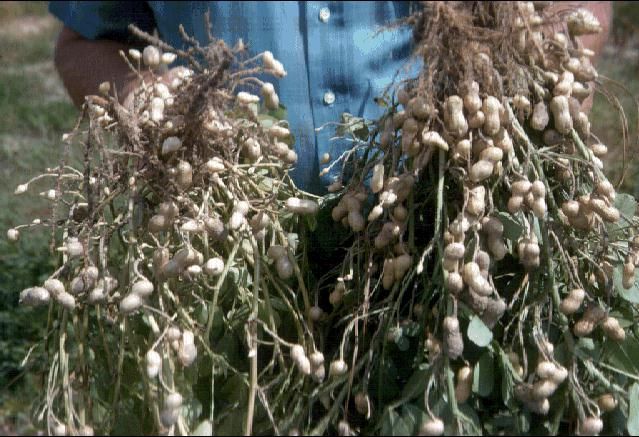Peanuts—Arachis hypogaea L.1
The peanut is also called goober, pindar, groundnut, and earth nut. While peanuts are most valuable as an agronomic crop here in Florida, they also are grown quite frequently in home vegetable gardens.

Credit: James M. Stephens, UF/IFAS
Description
The peanut plant is a low-growing, annual legume with a central upright stem. The numerous branches vary from low-flat to almost erect. Peanut varieties are separated into bunch and runner types. The nuts, which are legume pods like peas and beans, are closely clustered at the base of the bunch type. The runner varieties have nuts scattered along their prostrate branches from base to tip.
The peanut has a well-developed taproot with numerous lateral roots that extend several inches into the ground. Most roots have nodules but bear very few root hairs.
Peanut flowers are borne in the leaf axils, above or below ground, singly or in clusters of about three. It is not uncommon to find the blossoms with their yellow petals 3 inches below the soil surface. After self-pollination, the ovary that produces the pods is pushed into the soil by pegs, where the pod develops. The pods, containing usually from one to three seeds, develop only underground. Each seed is covered with a thin papery seed coat.
Culture
Peanut varieties are classified into three market types: runner, Spanish (bunch), and Virginia (both runner and bunch). For Florida, the following varieties are suggested: 'Florigiant,' a Virginia type maturing in about 135 days; 'Florunner' and 'Sunrunner', runner types maturing in about 135 days; and 'Starr,' a Spanish type maturing in about 120 days. Other Spanish types that may be planted are 'Tifspan,' 'Sancross,' and 'Tamnut 74.' Peanuts are adapted to all portions of Florida except South Florida. Prepare the garden soil as you would for other vegetables. For development of well-filled nuts, an adequate supply of calcium must be available in the fruiting zone. Agricultural gypsum is often applied beside the row after the plants are blooming. Plant seeds in the spring, beginning March 15 in Central Florida and April 1 in North Florida. Continue planting through May 15. Space seed 2 to 4 inches apart in rows 24 to 36 inches apart. Cover the seed 2 to 3 inches deep.
The peanut is a legume and, therefore, is capable of fixing nitrogen within its root nodules. Where peanuts are grown for the first time, inoculation of the seeds is advised. Use the cowpea group strain of inoculum. Granular application in the seed furrow at planting time is sufficient. Follow label directions.
Peanuts are attacked by a wide variety of insect and mite pests. Cutworms, armyworms, corn earworms, lesser cornstalk borers, wireworms, white grubs, leafhoppers, thrips, and spider mites are the most common. Most of the insecticides normally used on the other vegetables in the garden are suitable for use on peanuts. However, be sure to check the label on the container for special peanut directions. For disease control, some of the same fungicides that are used on the other garden vegetables may be used to control peanut leaf spots and rust.
Use
Peanuts from the garden are used either boiled or dried. Those used for boiling are harvested while the peanuts are still "green." When harvesting for dry usage, open a few pods before digging. Look to see if the seeds are turning darker, which indicates maturity. After digging the plants, pile them into fluffy, well-aerated piles (called windrows). Allow to "cure" in this fashion for 5 to 10 days of warm temperatures and relatively dry weather without rain. Reducing the moisture content of the seeds and pods is the main purpose of curing. (Proper curing is necessary to insure desirable flavor, texture, and overall quality.)


